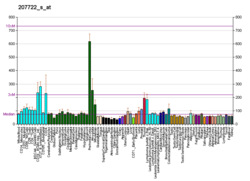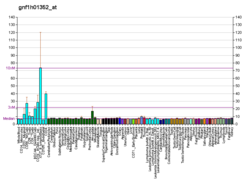Protein-coding gene in the species Homo sapiens
| BTBD2 |
|---|
|
| Available structures |
|---|
| PDB | Human UniProt search: PDBe RCSB |
|---|
|
|
| Identifiers |
|---|
| Aliases | BTBD2, BTB domain containing 2 |
|---|
| External IDs | OMIM: 608531; MGI: 1933831; HomoloGene: 32365; GeneCards: BTBD2; OMA:BTBD2 - orthologs |
|---|
| Gene location (Human) |
|---|
 | | Chr. | Chromosome 19 (human)[1] |
|---|
| | Band | 19p13.3 | Start | 1,985,438 bp[1] |
|---|
| End | 2,034,881 bp[1] |
|---|
|
| Gene location (Mouse) |
|---|
 | | Chr. | Chromosome 10 (mouse)[2] |
|---|
| | Band | 10|10 C1 | Start | 80,478,451 bp[2] |
|---|
| End | 80,492,905 bp[2] |
|---|
|
| RNA expression pattern |
|---|
| Bgee | | Human | Mouse (ortholog) |
|---|
| Top expressed in | - right frontal lobe
- right hemisphere of cerebellum
- anterior cingulate cortex
- stromal cell of endometrium
- right uterine tube
- amygdala
- right ovary
- ventricular zone
- apex of heart
- left ovary
|
| | Top expressed in | - interventricular septum
- dentate gyrus of hippocampal formation granule cell
- superior frontal gyrus
- primary visual cortex
- internal carotid artery
- external carotid artery
- muscle of thigh
- neural layer of retina
- zygote
- otic vesicle
|
| | More reference expression data |
|
|---|
| BioGPS | 
 | | More reference expression data |
|
|---|
|
| Gene ontology |
|---|
| Molecular function | - protein binding
- ubiquitin protein ligase binding
| | Cellular component | - cytoplasm
- SCF ubiquitin ligase complex
- cytosol
- P-body
| | Biological process | - proteasome-mediated ubiquitin-dependent protein catabolic process
- regulation of proteolysis
- neurogenesis
| | Sources:Amigo / QuickGO |
|
| Orthologs |
|---|
| Species | Human | Mouse |
|---|
| Entrez | | |
|---|
| Ensembl | | |
|---|
| UniProt | | |
|---|
| RefSeq (mRNA) | | |
|---|
| RefSeq (protein) | | |
|---|
| Location (UCSC) | Chr 19: 1.99 – 2.03 Mb | Chr 10: 80.48 – 80.49 Mb |
|---|
| PubMed search | [3] | [4] |
|---|
|
| Wikidata |
| View/Edit Human | View/Edit Mouse |
|
BTB/POZ domain-containing protein 2 is a protein that in humans is encoded by the BTBD2 gene.[5][6]
Function
The C-terminus of the protein encoded by this gene binds topoisomerase I. The N-terminus contains a proline-rich region and a BTB/POZ domain (broad-complex, Tramtrack and bric a brac/Pox virus and Zinc finger), both of which are typically involved in protein-protein interactions. Subcellularly, the protein localizes to cytoplasmic bodies.[6]
Interactions
BTBD2 has been shown to interact with TOP1.[7]
References
- ^ a b c GRCh38: Ensembl release 89: ENSG00000133243 – Ensembl, May 2017
- ^ a b c GRCm38: Ensembl release 89: ENSMUSG00000003344 – Ensembl, May 2017
- ^ "Human PubMed Reference:". National Center for Biotechnology Information, U.S. National Library of Medicine.
- ^ "Mouse PubMed Reference:". National Center for Biotechnology Information, U.S. National Library of Medicine.
- ^ Carim-Todd L, Sumoy L, Andreu N, Estivill X, Escarceller M (Jan 2001). "Identification and characterization of BTBD1, a novel BTB domain containing gene on human chromosome 15q24". Gene. 262 (1–2): 275–81. doi:10.1016/S0378-1119(00)00513-8. PMID 11179693.
- ^ a b "Entrez Gene: BTBD2 BTB (POZ) domain containing 2".
- ^ Xu L, Yang L, Hashimoto K, Anderson M, Kohlhagen G, Pommier Y, D'Arpa P (2002). "Characterization of BTBD1 and BTBD2, two similar BTB-domain-containing Kelch-like proteins that interact with Topoisomerase I". BMC Genomics. 3: 1. doi:10.1186/1471-2164-3-1. PMC 64781. PMID 11818025.
External links
- Human BTBD2 genome location and BTBD2 gene details page in the UCSC Genome Browser.
- Overview of all the structural information available in the PDB for UniProt: Q9BX70 (BTB/POZ domain-containing protein 2) at the PDBe-KB.
Further reading
- Maruyama K, Sugano S (Jan 1994). "Oligo-capping: a simple method to replace the cap structure of eukaryotic mRNAs with oligoribonucleotides". Gene. 138 (1–2): 171–4. doi:10.1016/0378-1119(94)90802-8. PMID 8125298.
- Andersson B, Wentland MA, Ricafrente JY, Liu W, Gibbs RA (Apr 1996). "A "double adaptor" method for improved shotgun library construction". Analytical Biochemistry. 236 (1): 107–13. doi:10.1006/abio.1996.0138. PMID 8619474.
- Yu W, Andersson B, Worley KC, Muzny DM, Ding Y, Liu W, Ricafrente JY, Wentland MA, Lennon G, Gibbs RA (Apr 1997). "Large-scale concatenation cDNA sequencing". Genome Research. 7 (4): 353–8. doi:10.1101/gr.7.4.353. PMC 139146. PMID 9110174.
- Suzuki Y, Yoshitomo-Nakagawa K, Maruyama K, Suyama A, Sugano S (Oct 1997). "Construction and characterization of a full length-enriched and a 5'-end-enriched cDNA library". Gene. 200 (1–2): 149–56. doi:10.1016/S0378-1119(97)00411-3. PMID 9373149.
- Xu L, Yang L, Hashimoto K, Anderson M, Kohlhagen G, Pommier Y, D'Arpa P (2003). "Characterization of BTBD1 and BTBD2, two similar BTB-domain-containing Kelch-like proteins that interact with Topoisomerase I". BMC Genomics. 3: 1. doi:10.1186/1471-2164-3-1. PMC 64781. PMID 11818025.
- Yamada A, Kawano K, Koga M, Takamori S, Nakagawa M, Itoh K (Jun 2003). "Gene and peptide analyses of newly defined lung cancer antigens recognized by HLA-A2402-restricted tumor-specific cytotoxic T lymphocytes". Cancer Research. 63 (11): 2829–35. PMID 12782588.
- Xu L, Yang L, Moitra PK, Hashimoto K, Rallabhandi P, Kaul S, Meroni G, Jensen JP, Weissman AM, D'Arpa P (Aug 2003). "BTBD1 and BTBD2 colocalize to cytoplasmic bodies with the RBCC/tripartite motif protein, TRIM5delta". Experimental Cell Research. 288 (1): 84–93. doi:10.1016/S0014-4827(03)00187-3. PMID 12878161.
- Colland F, Jacq X, Trouplin V, Mougin C, Groizeleau C, Hamburger A, Meil A, Wojcik J, Legrain P, Gauthier JM (Jul 2004). "Functional proteomics mapping of a human signaling pathway". Genome Research. 14 (7): 1324–32. doi:10.1101/gr.2334104. PMC 442148. PMID 15231748.
- Barrios-Rodiles M, Brown KR, Ozdamar B, Bose R, Liu Z, Donovan RS, Shinjo F, Liu Y, Dembowy J, Taylor IW, Luga V, Przulj N, Robinson M, Suzuki H, Hayashizaki Y, Jurisica I, Wrana JL (Mar 2005). "High-throughput mapping of a dynamic signaling network in mammalian cells". Science. 307 (5715): 1621–5. Bibcode:2005Sci...307.1621B. doi:10.1126/science.1105776. PMID 15761153. S2CID 39457788.
- Stelzl U, Worm U, Lalowski M, Haenig C, Brembeck FH, Goehler H, Stroedicke M, Zenkner M, Schoenherr A, Koeppen S, Timm J, Mintzlaff S, Abraham C, Bock N, Kietzmann S, Goedde A, Toksöz E, Droege A, Krobitsch S, Korn B, Birchmeier W, Lehrach H, Wanker EE (Sep 2005). "A human protein-protein interaction network: a resource for annotating the proteome". Cell. 122 (6): 957–68. doi:10.1016/j.cell.2005.08.029. hdl:11858/00-001M-0000-0010-8592-0. PMID 16169070. S2CID 8235923.




















